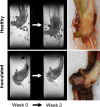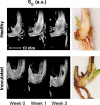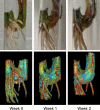Non-invasive assessment and visualization of Phytophthora cactorum infection in strawberry crowns using quantitative magnetic resonance imaging
- PMID: 38267614
- PMCID: PMC10808117
- DOI: 10.1038/s41598-024-52520-7
Non-invasive assessment and visualization of Phytophthora cactorum infection in strawberry crowns using quantitative magnetic resonance imaging
Abstract
Phytophthora cactorum is an oomycete species that causes enormous losses on horticultural crops, including strawberries. The purpose of this work was to investigate the alterations caused by P. cactorum inoculation in hydroponically grown strawberry plantlets (Fragaria × ananassa Duch.) using quantitative magnetic resonance imaging (qMRI). It was observed that with MRI, spatial and temporal progression of the infection could be observed in the crown using quantitative MR parameters, namely relaxation time maps. Relaxation times are numeric subject-specific properties that describe the MR signal behavior in an examined anatomical region. Elevated [Formula: see text] relaxation time values were observed inside the infected plant crowns with respect to the healthy references. The [Formula: see text] and [Formula: see text] values of healthy plants were small in the crown region and further diminished during the development of the plant. Furthermore, elevated [Formula: see text] relaxation time values were seen in regions where P. cactorum progression was observed in corresponding plant dissection photographs. Quantitative susceptibility maps (QSM) were calculated to estimate the local magnetic field inhomogeneities. The QSM suggests magnetic susceptibility differences near the center of the pith. This study provides novel non-invasive information on the structure and development of strawberry plants and the effects caused by the P. cactorum infection.
© 2024. The Author(s).
Conflict of interest statement
The authors declare no competing interests.
Figures








References
-
- FAO. Crops and livestock products. License: CC BY-NC-SA 3.0 IGO. Date Accessed: 2023-01-13. Food and Agriculture Organization of the United Nations https://www.fao.org/faostat/en/#data/QCL (2020).
-
- Thines M. Phylogeny and evolution of plant pathogenic oomycetes-a global overview. Eur. J. Plant Pathol. 2014;138:431–447. doi: 10.1007/s10658-013-0366-5. - DOI
-
- Maas JL. Compendium of Strawberry Diseases. APS Press; 1998. pp. 1–98.
-
- Erwin DC, Ribeiro OK. Phytophthora Diseases Worldwide. American Phytopathological Society; 1996. pp. 1–592.
-
- White PR. Studies of the physiological anatomy of the strawberry. J. Agric. Res. 1927;35:481–492.
MeSH terms
Grants and funding
LinkOut - more resources
Full Text Sources

